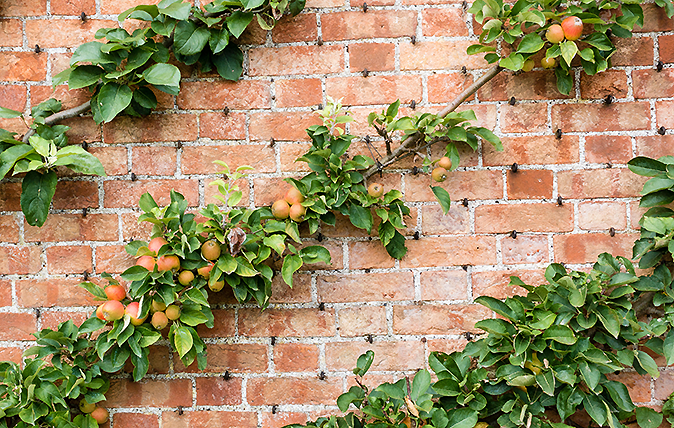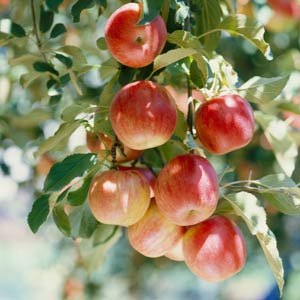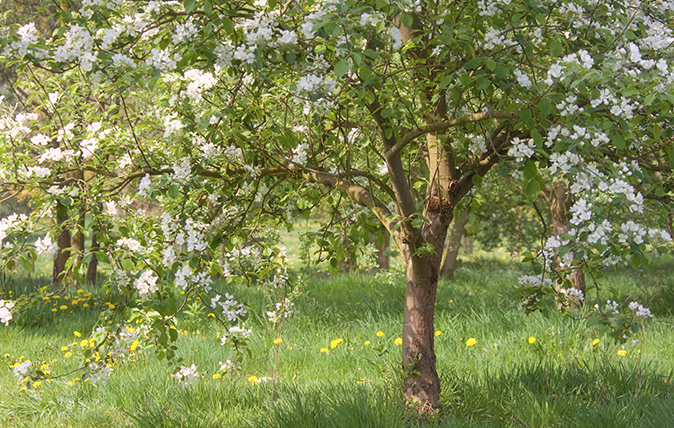
Last season, we had an exceptional fruit harvest, but we need to keep expanding the range. Chef has a special passion for pears, but the ripe fruit is such a fragile, messy thing, it’s hard to buy them ripened to full flavour — they must come from the garden.
To extend our crop, we’re planting new trees of Beurre Hardy and Doyenne du Comice, trained as fans against the garden wall. These two varieties are known to have the best flavour in our climate and, by growing them as restricted forms, we can give them the attention they need to produce the highest quality fruit. Training, blossom thinning, summer pruning and fruit thinning can take time, but you reap the rewards from the effort.
The same is true with apples. Cordons and espalier systems both work well in the art of growing the perfect apple. We have many free-standing trees, but this year, we’ve planted a new avenue of ‘step-overs’ to frame our vegetable beds. These are grown on a very dwarfing root stock, M27, and trained in a T shape along a wire, 18in from the ground.

Presentation is really important, but we never want to spray our fruit, so we only grow scabresistant varieties for the fruit bowl. Rajka, a beautiful red apple from the Czech Republic, has proved to be one of the best late varieties and Red Devil is an excellent earlier one, with never a blemish of scab. However, the tastiest apple we’ve grown in recent trials is Herefordshire Russet, which has a beautiful golden skin and complex sweet flavour. We were so pleased with it, we’ve just put in 30 new trees.
We grow nearly 100 different varieties of bush, tree and cane fruit, each selected by Chef for a specific purpose, so keeping accurate records of what we have is really important. Previously, our labels were made from tin strips punched with a letter stamp, which might have lived in the potting shed since Robinson’s day. These labels are full of character, but aren’t very clear or durable, so, recently, we made the decision to invest in professional printed labels of the sort used in botanical gardens, from IP Engraving. On each, we’ve recorded the fruit variety, planting date, country of origin and, where applicable, the rootstock on which it’s grafted. They certainly give an impression of order and organisation!
A good time to put these labels out is during winter pruning, when we have the opportunity to inspect each plant in detail and review the crop for improvements. Most of this work can be done any time the plants are dormant. It can be a useful job to save for bad weather, when the soil is too wet or frozen to be worked, but cold numb fingers and sharp secateurs can be a bad mix.
The nicest time to prune fruit is at the very end of winter in the first warm days. The spring may not have quite arrived, but the weak sun is a pleasure on the face and you can feel the plants beginning to wake as they’re trained. Each fruit variety has its own technique of pruning and it can seem like a lot of complicated information to take on.
Exquisite houses, the beauty of Nature, and how to get the most from your life, straight to your inbox.

Over the years, the gardener gets to know his plants like old friends and the pruning can be done with little conscious thought. However, we still, after all these years, regularly refer to our trusted copy of the RHS Encyclopedia of Gardening to keep us on track.
After all pruning is completed, it’s always good to give the fruit a feed with some bonemeal and apply a mulch of well-rotted organic material—one of the nicest things you can do for your plants. Mulching will help keep moisture in the soil and weeds out and, as it breaks down, it helps to improve the soil as the plant grows.
Mushroom compost or composted bark both make excellent mulch material and have the advantage of being sterile, but I prefer using our own homemade organic compost, which, I like to argue, is one of the most important ingredients that goes into Chef’s Michelin-star menu.
Tom Coward of Gravetye Manor
Toby Keel is Country Life's Digital Director, and has been running the website and social media channels since 2016. A former sports journalist, he writes about property, cars, lifestyle, travel, nature.

